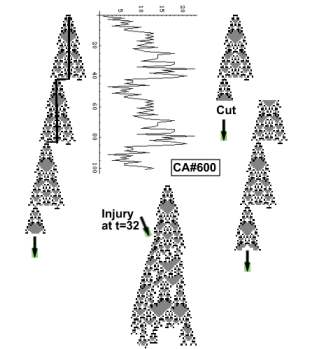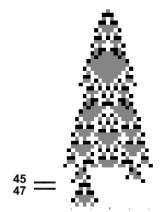 |
Periodicity
CA
behavior is determined by three number strings: state, rule and max-age. Under certain conditions a CA is periodic.
Like in the image below where a CA repeats its structure every 44 time units.
The graph depicts state content.
At
t=1 a zygote is planted and it starts growing until at t=41 cells start dying while one differentiates into a zygote (gray square
at t= 45), which generates a new CA. While the CA is symmetric, its
age structure is skewed and
zygote differentiates only on one side. When cut through, both cuts continue
the same cycle. The bottom CA was injured at t=32. One of its cells was
killed. Initially CA thrives, yet soon it dies.
 |
.
 |
The
experiment demonstrates some interesting biological features.
- CA has to mature before producing a progeny.
-In real life zygote differentiates into a somatic line which forms
our body and a germ line,
which carries the capacity to form another zygote. While
the first is mortal, germ line is immortal. This dichotomy is depicted also
in the CA, which is short lived, only its zygote is immortal. Here the
germ line is embedded in the structure of differentiating states, and
becomes visible after somatic cells have died
which starts at t= 41.
-Each new
zygote is seeded further from its mother, which lets the CA progeny advance
until it meets a partner.